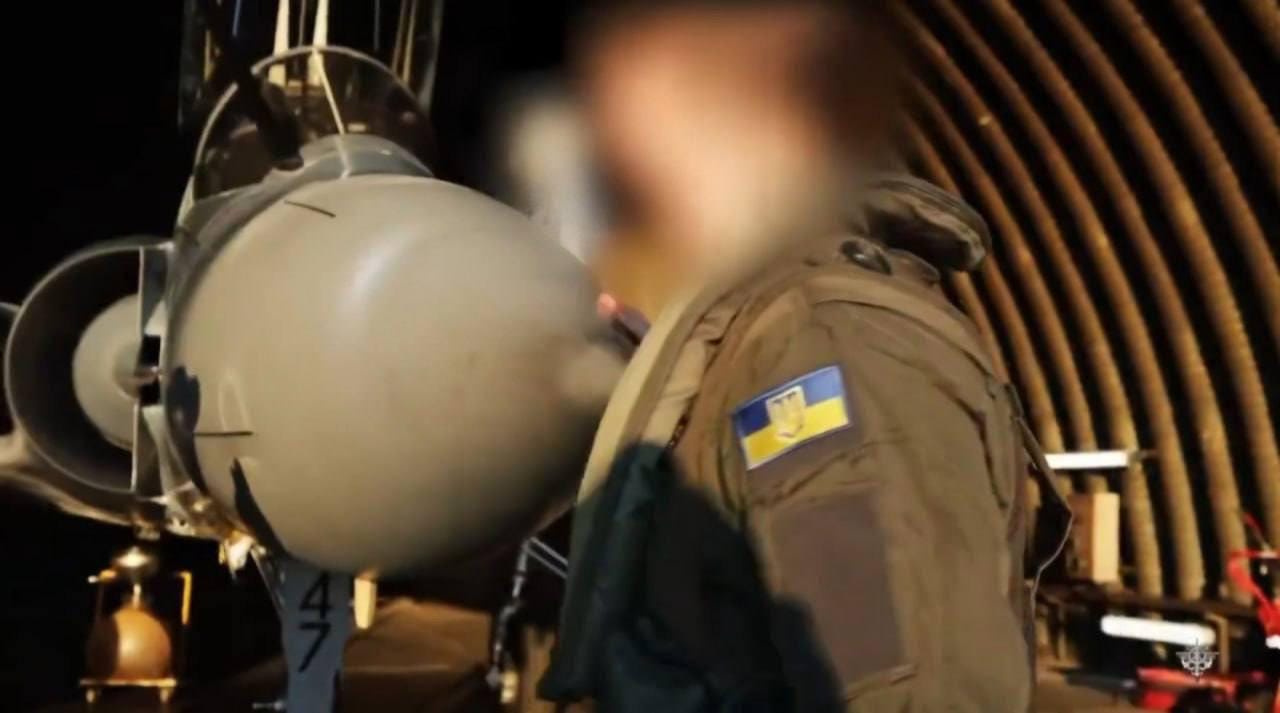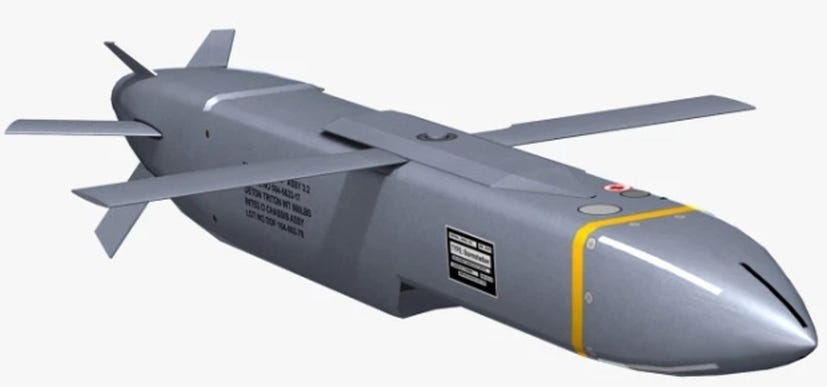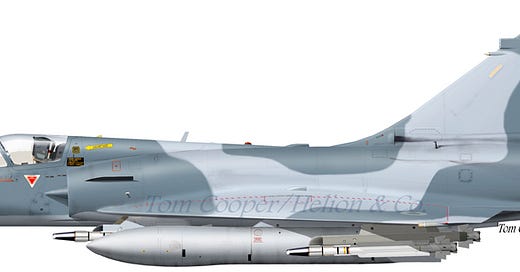Hello everybody!
On ‘something like popular request’, a few words on Mirage 2000F-5s that are meanwhile operated by the PSU (my abbreviated-abbreviation for Ukrainian Air Force & Air Defence Force, actually abbreviated with PSZSU)…
***
Ever since it emerged, back in the second half of the 1970s, this type was overshadowed by US-made jets like McDonnell-Douglas/Boeing F-15 and General Dynamics/Lockheed F-16, it was pressed into production a few years later. Because Paris is never subventioning its arms exports as much as Washington does, it’s also more expensive than F-16. Finally, one should keep in mind that the examples delivered to Ukraine were originally constructed over 30 years ago, and production of Mirage 2000s was stopped at least a decade ago. Means: acquisition of spares is likely to become a major trouble at some point in time - at least unless there is a solution like in case of certain other types, and one finds a company ‘somewhere abroad’ (for example in Poland, like the US Navy did in the case of its Grumman F-14 Tomcats back in the 2000s), ready to assume that task.


That said, one shouldn’t make a mistake and consider Mirage 2000 for ‘not as good’ as, for example, F-16. It’s at least as good as F-16C, and in certain regards much better. Indeed: there are disciplines in which Mirage 2000 is an outright ‘secret treasure trove’. This is particularly valid for its fire-control system and its electronic warfare suite. Moreover, it’s faster than F-16, and has a better instantaneous turn rate. The reason is that Mirage 2000 was always designed as ‘interceptor’, first and foremost. It was only then that other capabilities were added.
In this regards one should keep in mind that Dassault has pioneered the practice of custom-tailoring its combat aircraft to customers operational requirements. Not only already back in the late 1930s, but, especially so since the 1960s. When you buy a new car, you can pick engines of different power, whether you want a transparent roof, flat-screens in headrests of front seats, what should the on board computer be able to do, etc. In the case of their Mirages, the French were offering ‘pure’ interceptors (like Mirage IIICJ made for Israel, or IIIEA made for Argentina), simple fighter-bombers (like Mirage 5J, later 5M, made for Israel, Peru etc.), or complex fighter-bombers with multi-role capability (like Mirage IIIE). Obvious result are many sub-variants the precise designations and equipment are not always easy to follow.
Arguably, in the case of the Mirage 2000, one couldn’t pick a very different engine, but one could get very different avionics, and this was constantly updated over the time. For example: an ever more capable radar, and an ever more capable fire-control system - optimised not only for intercept-, but also for air-to-ground-, anti-ship-, reconnaissance and other operations. In turn, some customers said, ‘no, we do not need this or that’, and thus have got cheaper, or simpler, though also less-capable variants.
With other words: the type is highly adaptable - and more so than many other. A very good example for how much: mind that when they decided to hit that jihadist camp in Pakistan, in February 2019, the Indians didn’t do so with their ‘super-turbo’ Su-30MKis, but with 30-years-old (but significantly upgraded) Mirage 2000Is, using Israeli-made Popeye guided glide-bombs. Simply because - due to the summary of its different capabilities and major upgrades introduced over the time - the jet could do that job in a much better fashion.
Now, Mirage 2000 is a delta-winged aircraft, and relatively small (sure: it’s directly comparable in size to F-16, but much smaller than many of modern fighter-bombers). Thus, at the first look, its weapons configurations might appear confusing. For example, in the case of F-16, these are simple: there is one station (or ‘hardpoint’, also ‘pylon’) under the centreline (usually either unoccupied or used to carry drop tanks), and then there are three underwing hardpoints under each wing, plus wing-tip stations.
On Mirage 2000, there is also the centreline station and the ‘usual’ three underwing hardpoints, but there are also two additional weapons stations under the rear fuselage, either side of the centreline. This is why, when you check the profile I drew and posted above, or see the jet on the ground, you’re likely to see just 2, perhaps 4 MICA air-to-air missiles. But, when you look underneath it…
…there is a total of six, of which at least two are ‘hidden’ behind these big drop tanks.
The same hardpoints can be used to carry such air-to-ground guided weapons like the - meanwhile well-known to the Ukrainians - French-made ASM-250 HAMMER. Alternatively, two such weapons can be installed on a so-called ‘multiple ejector rack’ installed under the centreline, like here:
One might now want to know what are some of ‘special’ things about Mirage 2000?
Ironically, at least the origins of many of systems nowadays installed into the Mirage 2000F-5, can be traced back to an Iraqi order from 1983. The Iraqis wanted a jet that could either act as an interceptor, or deliver precise strikes hundreds of kilometres behind the enemy border or frontlines (the Kuwaitis, Saudis, and Emiratis were then also so kind to pay the few billions for the development of the resulting machinery - often through delivering crude purchased from Iran).
In order to find out exactly what the Iraqis need, the French then reached back upon Iraqi combat experiences from the war with Iran. And this is where there is a major difference to how are things done in other countries: at least in the French defence sector there is nothing like ‘professional military incompetence’, which I’ve discussed the last few days. Correspondingly, instead of declaring the Iran-Iraq war for ‘uninteresting’, ‘fought in fashion of the First World War’, and ‘not including any serious kind of air warfare’, people within the French defence secotr have learned a number of valuable lessons.
Namely, the Iran-Iraq War was the first armed conflict ever in which both sides operated interceptors armed with long-range- and medium-range air-to-air missiles: the Iranians operated their Grumman F-14 Tomcats, armed with AIM-54 Phoenix missiles, which could reach targets over 200km far, and McDonnell-Douglas F-4 Phantom IIs, armed with AIM-7E Sparrow missiles, with a range of 20km. The Iraqis operated Mirage F.1s armed with Super 530 missiles (range 30km), and Soviet-made MiG-23MF & MLs with R-23/24 missiles, with an effective range of 20-25km. Except for AIM-54, all of these weapons were semi-active radar homing weapons. Means: the fighter firing them had to guide them by pointing its radar at the target, until the missile either hit or missed. Unsurprisingly, there were lots of ‘missile shoot-outs’ between Iranians and Iraqis: say, F-4 fires an AIM-7, MiG-23 fires an R-23… and eventually both have to turn away and thus cease guiding their missiles, to avoid the enemy missile.
In other cases, the Iraqis (with French help) had to develop special tactics to combat the Iranian F-14s. These were patrolling at high altitudes behind the battlefield (12,000 metres and similar), and ‘lobbing’ their AIM-54s from 40-50-70km away… and the Iraqis lost lots of jets just while trying to approach them (which, of course, the Iraqis would never really admit: Iraq is a nation with a similar penchant for avoiding unpleasant facts, like Ukrainians).
That said, and although the AIM-54 had a range of about 200km, the mass was fired from 30-40, rarely more than 50km. In similar fashion, most of the time, the Iraqis were firing their Super 530s, R-23s, R-24s, and - towards the end of war - R-27s (from MiG-29s) from ranges of 15-20km.
Eventual conclusion was: a future air-to-air missile (this then became the MICA) needs no range of 70-80km, but it does need a ‘snap-up’ and ‘snap-down’ capability. For example to enable (future, and then still-born) Iraqi Mirage 2000s to combat Iranian F-14s from ‘usual’ ranges of around 25-30km, and while underway at a very low altitude. Correspondingly, MICA was designed to become capable of doing exactly that, and has an effective range of around 40km, but a ‘beautiful’ snap-up capability (some 13,000-15,000m), and excellent manoevreability.
This is one of details making Mirages ‘nice’ for the PSU. It means: should any Mirage ever manage to get ‘under’ one or another of Russian Su-35s - and, over Ukraine, these are usually operating almost in the same fashion like Iranian F-14s, back in the 1980s (see: patrolling at altitudes of 10,000-12,000, and lobbing their R-37Ms and R77s from afar) - they’ve got far better chances to kill one, than F-16s armed with AIM-120s (not to talk about MiG-29s and Su-27s and their obsolete R-27s…).
Admittedly, I do not expect this to happen any time soon. At least not before Ukrainians find a way to sneak upon Su-35s. That’s likely to take some time (and, I hope, is not going to result in any losses): back in 1981, the Iraqis also took a few months to learn how to sneak upon F-14s… and, although then successful (they did shot down 3 F-14s), the Iranians promptly countered with improved tactics, and then - after losing a few Mirages and MiG-23s - the Iraqis, de-facto, never tried this again…
Instead, one must expect the Mirages to ‘start their career’ in Ukraine in similar fashion like F-16s did, the last year: initially, they’ll primarily fly air defence operations. Because air defence of - for example - the remaining few power plants still operational, is a crucial issue for the survival of the country. This is where the avionics and armament of the Mirage - as well as the fact that the jet was originally designed as an interceptor - are offering nice advantages. Yes, ‘even’ vis-a-vis F-16s.
The RDY-2 radar installed into Ukrainian Mirage 2000F-5s can simultaneously track 24 targets. This is ‘ideal’ for countering typical Russian mass strikes with cruise missiles and attack drones. The fire-control system of the jet can then select ‘eight most important ones’, and simultaneously support deployment of four MICAs. I.e. a single Mirage can simultaneously engage four incoming cruise missiles (like Russian Kh-101) or attack drones (like Shaheds), from head-on aspect, and a range of around 20km. And the fire-control system is still going to keep the pilot updated on the movement of the other four potential targets, thus maintaining his situational awareness. Arguably: the avionics of the F-16C is, in theory, offering similar capabilities (‘even if not the same’) capabilities, but its pilots are regularly experiencing problems with trying to engage more than two incoming Russian missiles or drones at once (which is why it was such a ‘wonder’ when, sometimes the last year, one of them killed five Shaheds during the same sortie).
…and then there would be specific French electronic warfare systems installed in Mirage 2000s, which… think I’ll stop here. Let me just observe: yes, the mass of these was originally based on combat experiences from the Iran-Iraq War. And yes, all have been ‘significantly upgraded’ ever since (often to dismay of US pilots encountering them during different exercises).
Problem: as mentioned above, availability of spares for 30+ years-old Mirages is anything else than as good as that for F-16s, and their MICAs are also much more expensive than AIM-120s, while manufactured in lower numbers, too… Unless ‘somebody in Paris’ finally comes to the idea to start placing big orders for new weapons from the local defence sector, this might cause problems with re-supply in the future. And, gauging by what the CEO of Thales (the biggest French defence corporation) said only yesterday… sigh.. this is simply not happening. Apparently, Moron is still busy having great times with Satirical while daydreaming about some kind of super-peace-plans for Ukraine that are going to appease ‘even’ Dumpf…
Thus, we’ve got to expect that PSU Mirages to replace old and worn out Sukhoi Su-24M/MRs (which Ukraine can’t really overhaul, or do so only at a very slow pace) - as principal carriers of SCALP-EG cruise missiles. This is the ‘French version’ of the Storm Shadow, meanwhile manufactured entirely without any kind of US technology.

In a few months, when they have gathered enough experience - and thus self-confidence - in such- and in air defence operations, we can then expect Ukrainian Mirage 2000-pilots to do the same like their colleagues flying F-16s (and MiG-29s, and Su-25s and Su-27s), and start flying air strikes with guided bombs (like ASM-250 HAMMER) against targets along the frontline, too.
Until it’s so far, lets hope none of them is going to end like that poor F-16-pilot, killed by own air defences… nor like several MiG-29s and Su-27s destroyed while on the ground at air bases in the Dnipro- and Poltava areas, the last year, because the local commanders still have no ideas how to counter the Russian reconnaissance-strike complex.






You give me a great gift! Tom Cooper!
Thanks for this article,with too many data!
Is like my birday!
I hope the best ise for this airplane!
I i hope too,someone in france track and list all the mirage2000 in storage!
Or some one thinks about anothers countrys with this plane abroad.
And i have a cuestión...nobody think about put and okd amx30 tank chasis with a oerlikon system on top?
Too many in estorage,or amx chasis with artillery turret?
A nice movie about the Mirage 2000 is Sky Fighters, aka Les Chevaliers Du Ciel, where you can see Mirage 2000s battling other Mirage 2000s over Paris during the July 14th parade, which was filmed over Paris during the rehearsals of the July 14th parade.
The movie was filmed with little or no CGI, as they mounted in a recce pod a full sized movie camera, so a Mirage 2000 was filming other Mirage 2000s...
Not a lot of plot in the movie, but fun to watch, and it derives as a reboot from the Tanguy et Laverdure comics and tv show.